
Tonguefishes are flatfish in the family Cynoglossidae. They are distinguished by the presence of a long hook on the snout overhanging the mouth, and the absence of pectoral fins. Their eyes are both on the left side of their bodies, which also lack a pelvic fin. This family has three genera with a total of more than 140 species. The largest reaches a length of 66 cm (26 in), though most species only reach half that size or less. They are found in tropical and subtropical oceans, mainly in shallow waters and estuaries, though some species are found in deep sea floors, and even a few in rivers.

Pao abei is a species of freshwater pufferfish from the Mekong, Chao Phraya and Mae Klong river basins in Southeast Asia. It is named after Japanese ichthyologist Tokiharu Abe.

Scomberomorini is a tribe of ray-finned saltwater bony fishes that is commonly known as the Spanish mackerels, seerfishes or seer fish. This tribe is a subset of the mackerel family (Scombridae) – a family that it shares with three sister tribes, the tunas, mackerels, and bonitos, and the butterfly kingfish. Scomberomorini comprises 21 species across three genera. They are pelagic fish, fast swimmers and predatory in nature, that fight vigorously when caught. Seer fishes are mainly caught using hooks and lines.
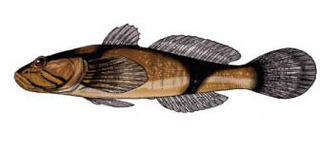
Benthophiloides brauneri is a species of goby, a benthophilic fish native to the fresh and brackish waters of the Black Sea, the Caspian Sea and the Sea of Azov as well as their surrounding rivers and estuaries. Despite the wide distribution, very few observations overall of this fish exist, and just one from the Caspian basin. It has been found in still waters at depths down to around 15 metres (49 ft). Males of this species can reach a length of 7.2 centimetres (2.8 in) SL while females only reach 5.1 centimetres (2.0 in) SL. This fish only lives for one year.
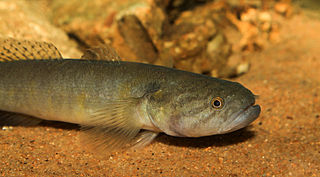
Bostrychus is a genus of fishes in the family Butidae mostly native to eastern Asia to Australia with one species being found along the Atlantic coast of Africa. While some of these species are restricted to freshwater, most can be found in marine, fresh and brackish waters.
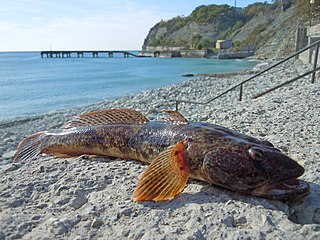
Mesogobius batrachocephalus, the knout goby or toad goby, is one of the species of gobiid fish native to the Black Sea and the Sea of Azov basins. It lives in estuaries and brackish water lagoons, occasionally in fresh waters, such as the coastal Lake Siutghiol in Romania. It prefers areas near cliffs with sandy, shelly or rocky substrates at depths of from 20 to 60 metres, sometimes down to 100 metres (330 ft). The knout goby is a piscivore. It can reach a length of 34.5 centimetres (13.6 in) SL and weight of 600 grams (1.3 lb). Maximum known age is eight years.
Pao cambodgiensis is a species of freshwater pufferfish native to the Mekong basin. It is also recorded from Dong Nai River. This species grows to a length of 15.3 centimetres (6.0 in) SL.

Cynoglossus is a genus of fish in the family Cynoglossidae. Most species are indigenous to the Indo-Pacific region, but there are also a few in warmer parts of the East Atlantic. They are commonly found in shallow waters on a muddy or sandy bottom, including estuaries and a few species are restricted to fresh water. One species Cynoglossus sinusarabici has invaded the Mediterranean Sea through the Suez Canal from the Red Sea, a process known as Lessepsian or Erythrean migration.

Paraplagusia is a genus of tonguefish. It is indigenous to the Indo-Pacific region, where commonly found in shallow waters on a muddy or sandy bottom. The largest species reaches 35 cm (14 in) in length.
Desmopuntius gemellus is a species of cyprinid fish endemic to Sumatra. This species can reach a length of 6.5 centimetres (2.6 in) SL.
Desmopuntius trifasciatus is a species of cyprinid fish endemic to Indonesia where it can be found in dark, slowly flowing blackwater rivers. This species can reach a length of 9.6 centimetres (3.8 in) SL.

The eastern tubenose goby is a species of gobiid fish native to fresh and brackish waters of the basins of the Sea of Azov and the Caspian Sea and has invaded the upper reaches of the Volga River from its native occurrence in the delta. This species prefers slow flowing rivers or still waters with plentiful rocks or vegetation. It can reach a length of 9 centimetres (3.5 in) SL. It is probably the same species as that recently treated as Proterorhinus semipellucidus.
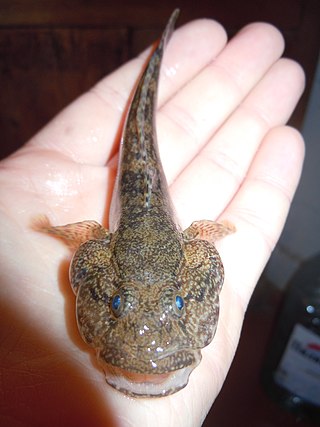
Ponticola gorlap, or the Caspian bighead goby, is a species of goby, a benthic fish native to the Caspian Sea basin. It is widespread in lower parts of many rivers in Iran, and also found in Azerbaijan and Turkmenistan. In Russia, it occurred in the lowest part of the Volga up to Astrakhan until 1977, but has thereafter spread upstream. In 2000 it was recorded as being established in the Ivankovo and Rybinsk Reservoirs in the Moscow region, and already invaded the Don drainage by way of the Volga–Don Canal in 1972. This species occurs in sheltered environments, such as inshore fresh or brackish waters of estuaries, lagoons, lakes and large rivers, where it prefers habitats with a well vegetated rock or firmly packed sand substrate. It can reach a length of 20 centimetres (7.9 in) SL, and a common size is 12 centimetres (4.7 in) SL.
Neogobius pallasi, the Caspian sand goby or the Caspian monkey goby, is a species of fish native to fresh and brackish waters of the Caspian Sea basin including the Volga drainage up to the vicinity of Moscow. It has been introduced into the Aral basin. This species of goby can reach a length of 20 centimetres (7.9 in) SL. It is also important to local commercial fisheries.
Drombus bontii is a species of goby native to the Indian Ocean from the Bazaruto Archipelago of Mozambique through to the tropical waters of the western Pacific Ocean. This species can reach a length of 7.1 centimetres (2.8 in) TL. The status of this species is questionable, with Maurice Kottelat considering it to be a junior synonym of Drombus triangularis.
Knipowitschia cameliae, the Danube delta dwarf goby, is a species of goby known only from the brackish and fresh waters of a lagoon south of the Danube Delta in Romania. This fish is a shallow water species being found in waters less than 1 metre (3.3 ft) deep. This species can reach a length of 3.2 centimetres (1.3 in) SL. This species has been assessed by the IUCN as Critically Endangered, possibly extinct, it was last recorded in 1994 and surveys in that year and 1998 have failed to record the species. The specific name honours Camelia Iliana Nalbant, the wife of the senior author.

The red dragonet is a species of dragonet native to the Indian Ocean and the western Pacific Ocean where it occurs at depths of from 70 to 600 metres. Males of this species reaches a length of 17 centimetres (6.7 in) SL while females only reach 13 centimetres (5.1 in) SL. This species is of commercial importance to local fisheries.
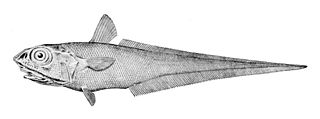
Macrourus berglax, also known as the roughhead grenadier or onion-eye grenadier, is a species of marine ray-finned fish in the family Macrouridae. It is a deep-water fish found in the Atlantic Ocean.












